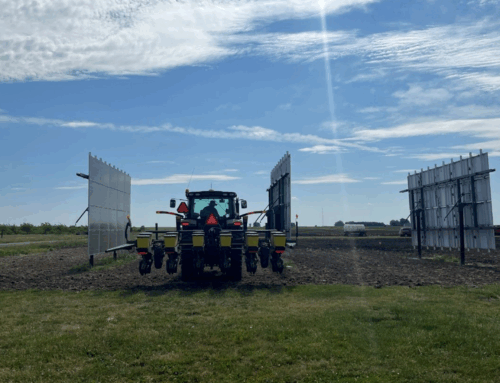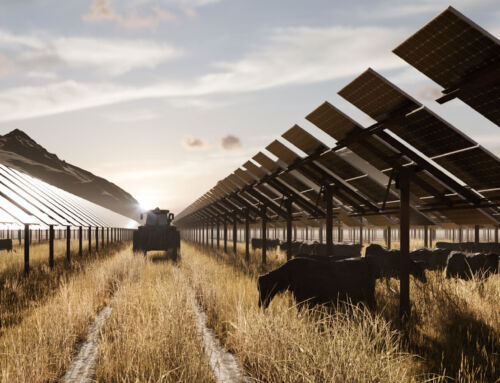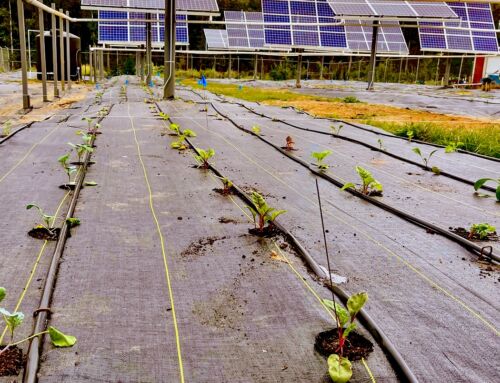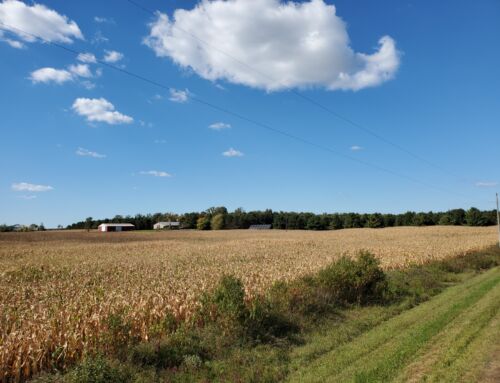Agrivoltaics is the simultaneous use of land for solar panels and agriculture. This technology is sometimes called agrophotovoltaics, agrisolar, dual-use solar, or low-impact solar. Agrivoltaics presents a working relationship between agriculture and solar energy production. Instead of these industries being competitors, they complement each other by allowing agricultural space to remain working land. By pairing solar with agriculture, agrivoltaics, or dual-use solar can provide space for crops, grazing, and native habitats to continue thriving between the panels.
What problem does agrivoltaics solve?
With increased renewable energy goals and interest, solar installation can pose a number of problems when land is misused, forcing out farmers and their crops. Large-scale solar installations and operations can overtake agricultural land and their crops. When this happens, food production is replaced for the sake of renewable energy goals. But, if crops and solar production engage in a dual-use solution, solar installations can ensure crop production isn’t disrupted.
Agrivoltaics protects agricultural land and ensures that crops can continue food production. Dual-use solar isn’t just useful for continued agricultural purposes; livestock can also graze under the solar panels, limiting the need for maintenance and trimming underneath the panels.
How much land does agrivoltaics use?
Solar power uses 10 times as much land per unit of power than fossil fuels. Land acquisition is challenging, but according to the U.S. Department of Energy (DOE), the availability of land, or lack thereof, does not pose limitations to solar installation.
According to a study conducted by the DOE’s Solar Futures Study, “Various approaches are available to mitigate local impacts or even enhance the value of land that hosts solar systems. Installing PV systems on waterbodies, in farming or grazing areas, and in ways that enhance pollinator habitats are potential ways to enhance solar energy production…” Currently, agriculture occupies about 43% of the contiguous 48 states. The Solar Futures Study indicates that prioritizing disturbed lands (i.e. quarries, gravel pits, contaminated areas that could be repurposed) and dual-use land opportunities will be crucial to mitigating further destruction of land and crops.
The Solar Futures Study report estimates that at least 40% of the country’s electricity will be provided by solar by 2035. This would require 5.7 million acres of land, which is less than 0.3% of the United States. The land that is often most desirable for agriculture is also appealing for solar because of the plentiful sun available. However, this is why dual-use is intriguing: the sharing of land between solar and agriculture preserves land while also providing economical and ecological benefits.
What are the benefits of agrivoltaics?
Agrivoltaics ensures that agriculture is not disrupted but rather optimized. Dual-use solar can ensure mutual benefits for agricultural land, while also having long-term benefits on an area’s ecosystem. Likewise, agrivoltaics can offer cooling to crops that might need some shade. The panels can protect crops from intense sun rays, providing shade and cooler temperatures. The plants can then naturally cool themselves by giving off water vapor, which in turn cools the solar panels. This symbiotic relationship lessens a farmer’s work on hot days, offers shade to plants, and increases panel efficiency.
Practically, this means that solar panels help keep plants cool, making them more productive. Farmers have the opportunity to increase production by at least 10% by using dual-use solar.
Agrivoltaics has the potential to benefit farmers by improving crop field and crop resistance in cases of extreme weather conditions. By implementing dual-use solar, farmers can maintain their crops while also finding opportunities for increased production.
Invest in the Future of Agrivoltaics
Agriculture and renewable energy don’t need to be at odds with each other. They can successfully and symbiotically exist together. Hybrid land use ensures agricultural land is protected while also prioritizing green energy technology. Agrivoltaics underscores the mutual benefits of solar, agricultural crops, natural resources, and native lands.
When designed properly, dual-solar can be a flexible form of green technology that can adapt to the changing economy and evolving agricultural space. If a crop is no longer viable or profitable, the land can be used for grazing, or vice versa. Agrivoltaics is meant to be a dynamic form of renewable energy and agricultural production that can evolve as needed to accommodate future generations.
Continued improvements to solar technology and management will help build community support for solar deployment. MT Solar aims to solve ecological and economic problems through agrivoltaic mounting solutions. You can read more about our work here.





